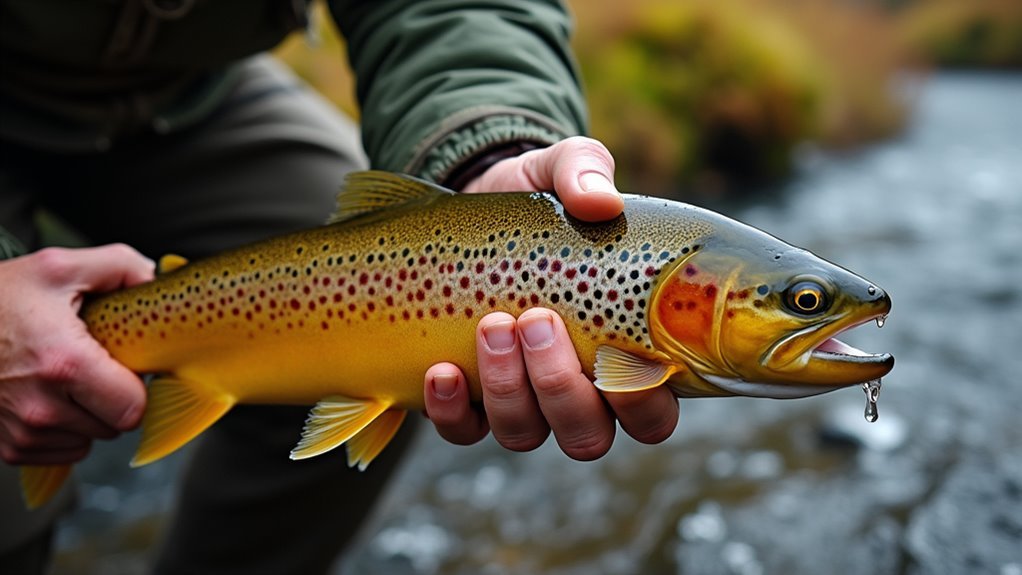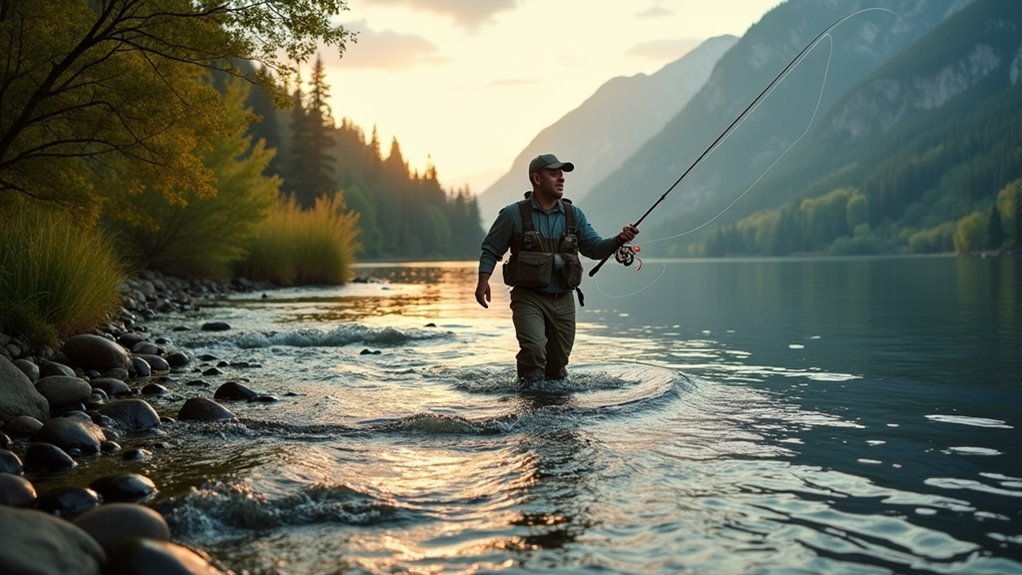To master brown trout fishing, you’ll need to adapt to their seasonal patterns. In spring, target 50°F waters near fallen trees; summer calls for dawn/dusk fishing in deep pools; fall offers trophy opportunities with aggressive pre-spawn strikes; and winter requires midday fishing with slow retrieves. Match your gear to the environment—lighter tackle for streams, heavier for lakes. Perhaps most importantly, learn to read where browns hide: undercut banks, deep pools, and shifting zones between currents. The nocturnal tendencies of trophy browns might surprise you.
Targeting Brown Trout Through the Seasons

When the seasons shift, so do your brown trout fishing strategies.
Spring brings those magic 50°F water temperatures that wake browns from their winter sluggishness. I’ve found early mornings near fallen trees particularly productive this time of year.
Summer requires patience—target dawn and dusk when temperatures climb. Perhaps try deeper pools where browns seek cooler refuge. Those big ones? They’re usually nocturnal during hot months.
Fall might be your best shot at trophy browns. They’re aggressive pre-spawn, striking larger lures with surprising ferocity.
And winter? Don’t overlook midday fishing between 11-2. The cold makes them lethargic, so slow down your retrieves considerably.
Essential Gear and Tackle Selection
Although catching brown trout requires skill and knowledge, selecting the right gear dramatically increases your chances of success.
I think a medium-light to medium-action rod around 6-7 feet offers the most versatility for most situations.
Your reel should match your fishing style—spinning reels work great for most anglers, while fly fishers need a balanced fly reel.
Choose your reel wisely—spinning reels for general use, fly reels for those dedicated to the art of fly fishing.
Line weight varies, but 4-6 pound test is generally ideal for streams, perhaps bumping up to 8-10 pounds for lake fishing where bigger browns lurk.
Don’t forget quality hooks (size 8-14) and perhaps some split shot.
Terminal tackle matters just as much as your rod and reel.
Reading the Water: Where Browns Hide
The art of reading water separates casual fishermen from successful brown trout anglers. Learning where browns hide is perhaps the most essential skill you’ll develop. I think once you understand their preferred holding spots, your catch rate will improve dramatically.
| Structure | Spring | Summer | Fall | Winter |
|---|---|---|---|---|
| Undercut Banks | Very Good | Good | Excellent | Fair |
| Deep Pools | Good | Excellent | Good | Best |
| Fallen Trees | Excellent | Good | Good | Poor |
| Riffles | Good | Fair | Good | Poor |
| Tail-outs | Fair | Poor | Excellent | Poor |
Focus on changes between fast and slow water. Browns often lurk just beyond the current, conserving energy while waiting for food to drift by.
Proven Techniques for Stream vs. Lake Fishing

Stream fishing and lake fishing for brown trout require fundamentally different approaches, yet both can yield impressive results when you understand the nuances.
In streams, I think focusing on reading current breaks and identifying holding areas is critical, while lake fishing often demands more patience and strategic depth selection.
- Cast upstream and drift naturally with the current in streams
- Use larger profile baits in lakes where browns hunt bigger prey
- Target early mornings or evenings in both environments for peak activity
- Perhaps try trolling methods in lakes, but stick to precise presentations in streams
Temperature drives behavior in both settings, so always adjust your approach accordingly.
Mastering Night Fishing for Trophy Browns
Hunting for trophy brown trout under the cover of darkness can transform your fishing experience from merely enjoyable to truly extraordinary.
The biggest browns often feed nocturnally, making night fishing perhaps the most effective strategy for landing that monster you’ve been chasing.
Focus on deeper pools and open water areas, as browns typically shift locations after sunset.
I think large profile baits work best – try jerking movements followed by long pauses with streamers.
Topwater tactics can be surprisingly effective too.
Don’t rush your retrieves. These night-feeding giants are deliberate, and patience often pays dividends.
Selecting the Right Bait for Every Situation
Selecting the perfect bait for brown trout fishing might be the single most important factor in your success on the water.
I’ve found that brown trout can be picky eaters, sometimes turning down perfectly good offerings for seemingly no reason. That’s why having a versatile selection is vital – you need to match both the conditions and the trout’s mood.
- Use silver spoons in clear water, gold in murky conditions
- Try nightcrawlers or trout worms for reliable action with smaller browns
- Switch to minnows under slip bobbers when targeting trophy-sized fish
- Consider seasonal patterns – eggs during spawning, grasshoppers in late summer
Frequently Asked Questions
How Can I Distinguish Brown Trout From Other Trout Species?
Look for brown trout’s distinctive dark spots with lighter halos on their flanks, buttery-brown coloration, often reddish spots, and square-shaped tail compared to other trout’s more forked tails.
What’s the Best Way to Practice Catch and Release With Browns?
Handle hungry browns with hands moistened first. Use barbless hooks, keep fish in water when possible, and quickly release them. Never touch gills and minimize air exposure to guarantee survival.
How Does Barometric Pressure Affect Brown Trout Feeding Patterns?
Barometric pressure greatly impacts brown trout feeding. You’ll notice they feed aggressively before pressure drops (storms approaching), while high, stable pressure makes them more selective and sluggish in their feeding habits.
Can Brown Trout Hybridize With Other Trout Species?
You’d think brown trout would keep to themselves, but they’ll readily hybridize with Atlantic salmon, brook trout, and other trout species, creating distinctive “tiger trout” and “brown salmon” hybrids.
What Water Quality Parameters Are Most Critical for Brown Trout Survival?
You’ll need water temperatures between 40-65°F, high oxygen levels, and moderate pH (6.5-8.5) for brown trout survival. Clean, clear water with minimal pollution is essential.